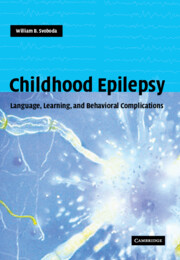Book contents
- Frontmatter
- Contents
- Preface
- Glossary
- 1 Looking ahead
- Part I Speech and language problems
- Part II Learning problems
- Part III Behavior problems
- 27 Mental health needs
- 28 Psychologic development
- 29 Seizure types and modifying factors
- 30 Overview: extrinsic factors
- 31 Behavior problems: general
- 32 Attention deficit disorders
- 33 Anxiety disorders
- 34 Mood disorders
- 35 Disruptive behavior problems
- 36 Psychoses of epilepsy
- 37 Non-epileptic events
- 38 Possible treatment issues
- 39 Helping with psychiatric problems
- 40 Epilog
- Index
- References
33 - Anxiety disorders
from Part III - Behavior problems
Published online by Cambridge University Press: 26 October 2009
- Frontmatter
- Contents
- Preface
- Glossary
- 1 Looking ahead
- Part I Speech and language problems
- Part II Learning problems
- Part III Behavior problems
- 27 Mental health needs
- 28 Psychologic development
- 29 Seizure types and modifying factors
- 30 Overview: extrinsic factors
- 31 Behavior problems: general
- 32 Attention deficit disorders
- 33 Anxiety disorders
- 34 Mood disorders
- 35 Disruptive behavior problems
- 36 Psychoses of epilepsy
- 37 Non-epileptic events
- 38 Possible treatment issues
- 39 Helping with psychiatric problems
- 40 Epilog
- Index
- References
Summary
Anxiety and epilepsy have been associated in the minds of people since antiquity (Scicutella, 2001). Not purely a mood, thought, or autonomic disorder, anxiety is a unique phenomenon in genesis and expression that needs multidisciplinary efforts to be understood (Goldstein & Harden, 2000).
Anxiety disorders include phobic disorders, anxiety states including panic disorders, generalized anxiety disorders, obsessive–compulsive disorders, and post-traumatic stress disorder (Trimble, 1988). Over half of adult patients in an epilepsy clinic have significant anxiety symptoms (Francis et al., 1966; Ettinger et al., 1998).
In children, anxiety in epilepsy is more difficult to recognize than disorders with more overt behavior difficulties such as ADHD or conduct disorders. When a child presents with anxiety symptoms, a family history of anxiety is not uncommon. At least one of every six children with epilepsy seen in an epilepsy clinic meets the criteria for anxiety (Ettinger et al., 1998). An even higher number may experience fear and anxiety related to numerous factors, including fear of death, brain damage, or mental Retardation, and social phobias as a result of having seizures in public (Mittan & Locke, 1982). Sleep anxiety and seizure frequency appear to be related. Children with epilepsy have a higher rate of sleep disorders, particularly poor-quality sleep and anxieties about sleep (Ettinger et al., 1998).
Parents have different anxieties to their children, leading them to be overprotective or overindulgent. Such fears may be transmitted to the children.
- Type
- Chapter
- Information
- Childhood EpilepsyLanguage, Learning and Behavioural Complications, pp. 494 - 507Publisher: Cambridge University PressPrint publication year: 2004



